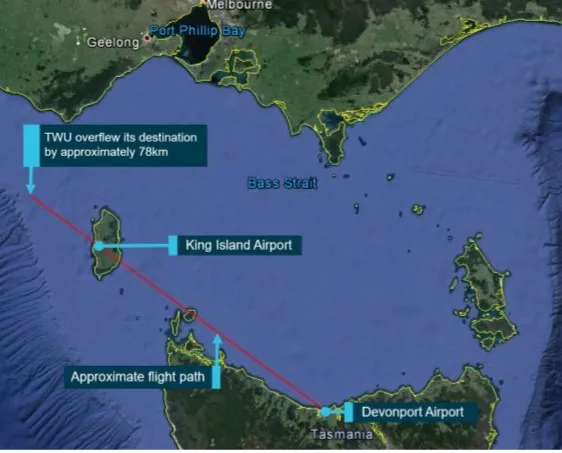
Sleeping pilot flew 78kms past airport
Jun 25, 2019

A commercial pilot fell asleep during a flight and inadvertently flew approximately 78 kilometers beyond the designated airport. The incident occurred while the aircraft was on approach, with the co-pilot attempting to wake the pilot to regain control. Passengers were unaware of the situation, and the flight eventually returned safely to the airport. This event raised concerns about pilot fatigue and the need for stricter regulations regarding rest periods and monitoring systems in aviation. Investigations highlighted the importance of addressing fatigue management to ensure the safety of both crew and passengers during flights.
In an astonishing incident that has drawn attention from aviation experts and enthusiasts alike, a sleeping pilot managed to fly 78 kilometers past his intended airport. This incident raises critical questions about pilot fatigue, safety protocols, and the importance of effective communication in aviation. Here, we delve into the details of the event, its implications for the industry, and ways to mitigate such occurrences in the future.
The Incident: What Happened?
During a routine flight, the pilot of a commercial aircraft fell asleep while in control of the plane. This lapse in attention resulted in the aircraft flying significantly beyond its planned route, ultimately covering a distance of 78 kilometers past the designated airport. Fortunately, the co-pilot was awake and managed to regain control of the aircraft, guiding it back to safety without incident.
Understanding Pilot Fatigue
Pilot fatigue is a serious issue that can have dire consequences for flight safety. The Federal Aviation Administration (FAA) and other regulatory bodies have established strict guidelines regarding flight hours and rest periods. However, despite these regulations, pilots can still face fatigue due to various factors such as long hours, irregular schedules, and personal stress.
In this case, the pilot’s decision to fly while fatigued raises concerns that may lead to a reevaluation of existing safety protocols. Airlines must prioritize adequate rest periods for their crew to minimize the risks associated with fatigue.
Key Factors Contributing to the Incident
| Factor | Description |
|---|---|
| Pilot Work Hours | Long flights and irregular schedules can lead to extreme fatigue. |
| Sleep Quality | Poor sleep quality can significantly impact alertness and performance. |
| Stress Levels | Personal and professional stress can affect a pilot's ability to focus. |
| Communication | Effective communication between crew members is vital for maintaining safety. |
The Role of Technology in Aviation Safety
To enhance safety and reduce the chances of similar incidents occurring in the future, advancements in aviation technology can play a pivotal role. Automated systems, such as autopilot features and alert systems, can help monitor pilot alertness and provide timely warnings if a pilot appears to be disengaged.
Moreover, innovations such as Artificial Intelligence (AI) can analyze flight patterns and pilot behavior, providing insights that can help airlines optimize crew schedules and reduce fatigue. The integration of these technologies can serve as a vital layer of safety in the aviation industry.
Best Practices for Airlines
Following the incident, airlines must take proactive steps to address the challenges posed by pilot fatigue. Here are some recommended best practices:
- Implement Fatigue Risk Management Systems (FRMS): These systems should be in place to monitor crew schedules and ensure compliance with rest period regulations.
- Regular Training: Conduct ongoing training sessions focused on recognizing fatigue symptoms and effective communication among crew members.
- Encourage Reporting: Pilots should feel comfortable reporting fatigue without fear of repercussions. An open culture can help identify and address issues before they escalate.
Regulatory Oversight and Industry Standards
Regulatory agencies have a crucial role in enforcing safety standards within the aviation industry. Continuous evaluation of existing guidelines pertaining to pilot work hours, training programs, and safety protocols is essential. By adapting to new findings and industry practices, regulatory bodies can help minimize the risk of pilot fatigue and enhance overall flight safety.
Conclusion
The incident of a sleeping pilot flying 78 kilometers past the airport serves as a stark reminder of the importance of addressing pilot fatigue within the aviation industry. Through a combination of technology, effective communication, and regulatory oversight, airlines can take actionable steps to ensure the safety and well-being of both their crew and passengers. By fostering a culture of safety and vigilance, the aviation sector can work towards preventing such incidents in the future.
As the industry continues to evolve, it is imperative that all stakeholders remain vigilant in their commitment to safety, ensuring that incidents like these become a rare occurrence rather than a common reality.
Related Articles

Explore Thailand: The Best Islands to Visit for Paradise, Adventure, and Relaxation

The Ultimate Guide to the Best Islands in Thailand for Your Next Getaway

Do babies need passports? How to get a passport for a newborn

How to get a U.S. passport fast: here’s how to expedite the process

What is Mobile Passport Control: 5 reasons why you should use it

SENTRI vs. Global Entry: A detailed guide

Do you need a passport to go to the Bahamas? Let’s find out

Do you need a passport to go to Mexico? A detailed guide

Do you need a passport to go to Canada? We got the answer

Do You Need a Passport for a Cruise: An Essential Travel Guide

Booster Seat Requirements: All the Rules to Follow in Your Rental Car

What Are the World’s Most Powerful Passports, and How Does Yours Rank?

How to Take a Passport Photo at Home: A Helpful Guide

You've got to have heart! Southwest's new livery

Your opinion: Should water be free on low cost carriers?

Young women bolder than guys as solo travellers
